Climate Change and Food Insecurity in Nepal: A Case Study
VerifiedAdded on 2023/06/08
|13
|3373
|215
AI Summary
This case study discusses the impact of climate change on food and nutrition security in Nepal. It covers the effects of climate change on agriculture, weather patterns, and the economy of the country. The study also suggests strategies that the government can adopt to address the situation. The article includes a literature survey and discusses the impact of climate change on agricultural lands.
Contribute Materials
Your contribution can guide someone’s learning journey. Share your
documents today.
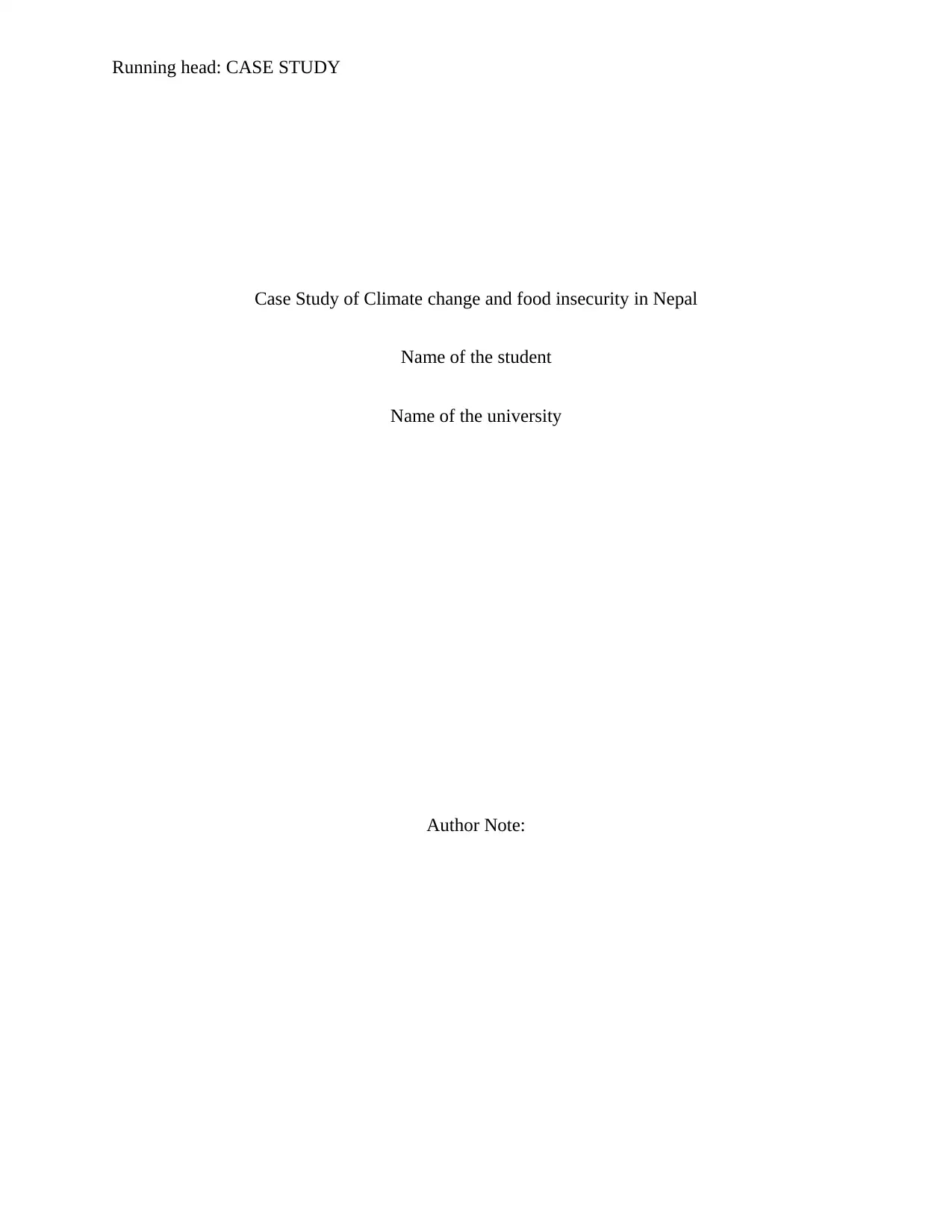
Running head: CASE STUDY
Case Study of Climate change and food insecurity in Nepal
Name of the student
Name of the university
Author Note:
Case Study of Climate change and food insecurity in Nepal
Name of the student
Name of the university
Author Note:
Secure Best Marks with AI Grader
Need help grading? Try our AI Grader for instant feedback on your assignments.

2
FOOD AND NUTRITION SECURITY IN NEPAL
Table of Contents
Introduction......................................................................................................................................3
Climate change................................................................................................................................3
Weather and Agriculture..................................................................................................................6
Literature survey..............................................................................................................................7
Impact of Climate Change on agricultural lands...........................................................................10
Conclusion.....................................................................................................................................10
References......................................................................................................................................12
FOOD AND NUTRITION SECURITY IN NEPAL
Table of Contents
Introduction......................................................................................................................................3
Climate change................................................................................................................................3
Weather and Agriculture..................................................................................................................6
Literature survey..............................................................................................................................7
Impact of Climate Change on agricultural lands...........................................................................10
Conclusion.....................................................................................................................................10
References......................................................................................................................................12
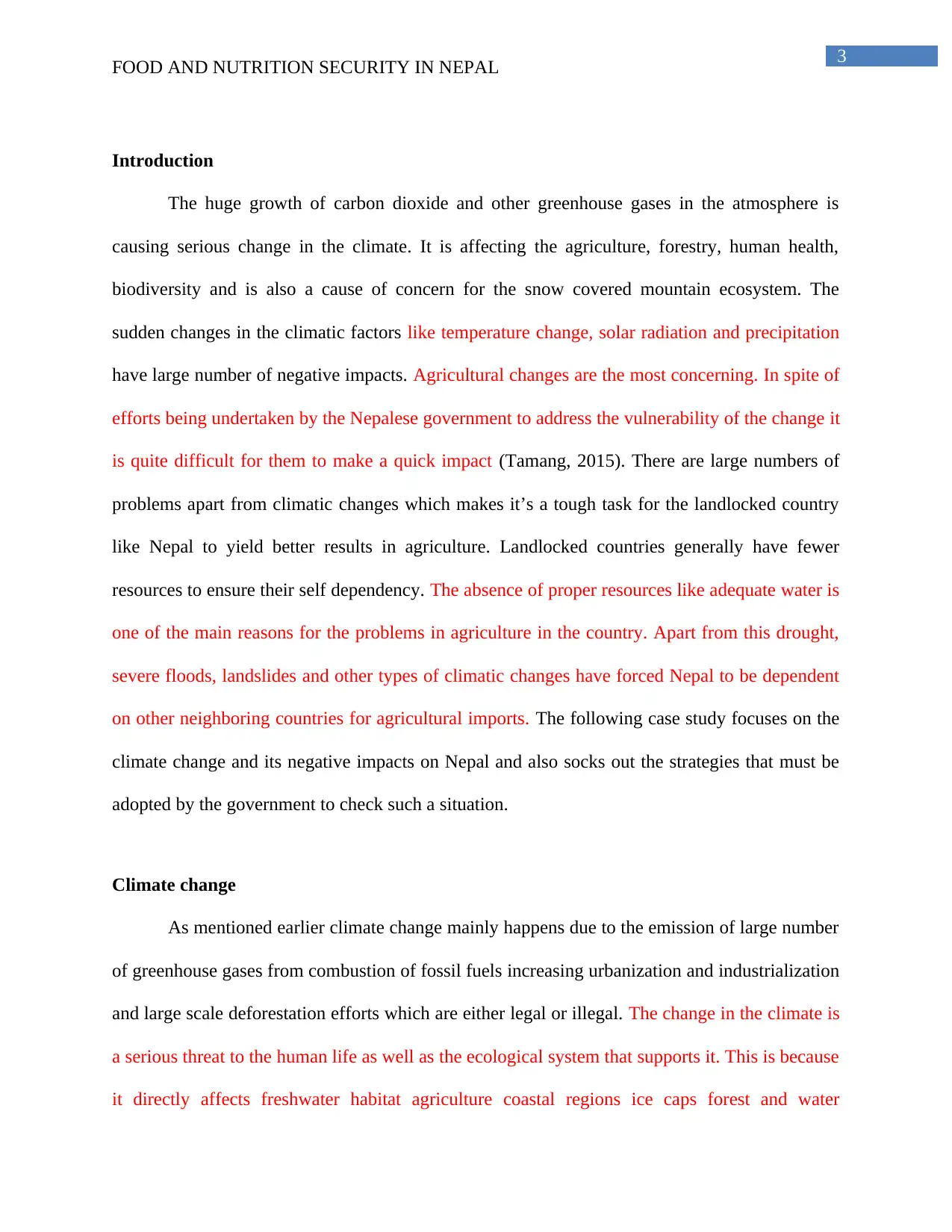
3
FOOD AND NUTRITION SECURITY IN NEPAL
Introduction
The huge growth of carbon dioxide and other greenhouse gases in the atmosphere is
causing serious change in the climate. It is affecting the agriculture, forestry, human health,
biodiversity and is also a cause of concern for the snow covered mountain ecosystem. The
sudden changes in the climatic factors like temperature change, solar radiation and precipitation
have large number of negative impacts. Agricultural changes are the most concerning. In spite of
efforts being undertaken by the Nepalese government to address the vulnerability of the change it
is quite difficult for them to make a quick impact (Tamang, 2015). There are large numbers of
problems apart from climatic changes which makes it’s a tough task for the landlocked country
like Nepal to yield better results in agriculture. Landlocked countries generally have fewer
resources to ensure their self dependency. The absence of proper resources like adequate water is
one of the main reasons for the problems in agriculture in the country. Apart from this drought,
severe floods, landslides and other types of climatic changes have forced Nepal to be dependent
on other neighboring countries for agricultural imports. The following case study focuses on the
climate change and its negative impacts on Nepal and also socks out the strategies that must be
adopted by the government to check such a situation.
Climate change
As mentioned earlier climate change mainly happens due to the emission of large number
of greenhouse gases from combustion of fossil fuels increasing urbanization and industrialization
and large scale deforestation efforts which are either legal or illegal. The change in the climate is
a serious threat to the human life as well as the ecological system that supports it. This is because
it directly affects freshwater habitat agriculture coastal regions ice caps forest and water
FOOD AND NUTRITION SECURITY IN NEPAL
Introduction
The huge growth of carbon dioxide and other greenhouse gases in the atmosphere is
causing serious change in the climate. It is affecting the agriculture, forestry, human health,
biodiversity and is also a cause of concern for the snow covered mountain ecosystem. The
sudden changes in the climatic factors like temperature change, solar radiation and precipitation
have large number of negative impacts. Agricultural changes are the most concerning. In spite of
efforts being undertaken by the Nepalese government to address the vulnerability of the change it
is quite difficult for them to make a quick impact (Tamang, 2015). There are large numbers of
problems apart from climatic changes which makes it’s a tough task for the landlocked country
like Nepal to yield better results in agriculture. Landlocked countries generally have fewer
resources to ensure their self dependency. The absence of proper resources like adequate water is
one of the main reasons for the problems in agriculture in the country. Apart from this drought,
severe floods, landslides and other types of climatic changes have forced Nepal to be dependent
on other neighboring countries for agricultural imports. The following case study focuses on the
climate change and its negative impacts on Nepal and also socks out the strategies that must be
adopted by the government to check such a situation.
Climate change
As mentioned earlier climate change mainly happens due to the emission of large number
of greenhouse gases from combustion of fossil fuels increasing urbanization and industrialization
and large scale deforestation efforts which are either legal or illegal. The change in the climate is
a serious threat to the human life as well as the ecological system that supports it. This is because
it directly affects freshwater habitat agriculture coastal regions ice caps forest and water
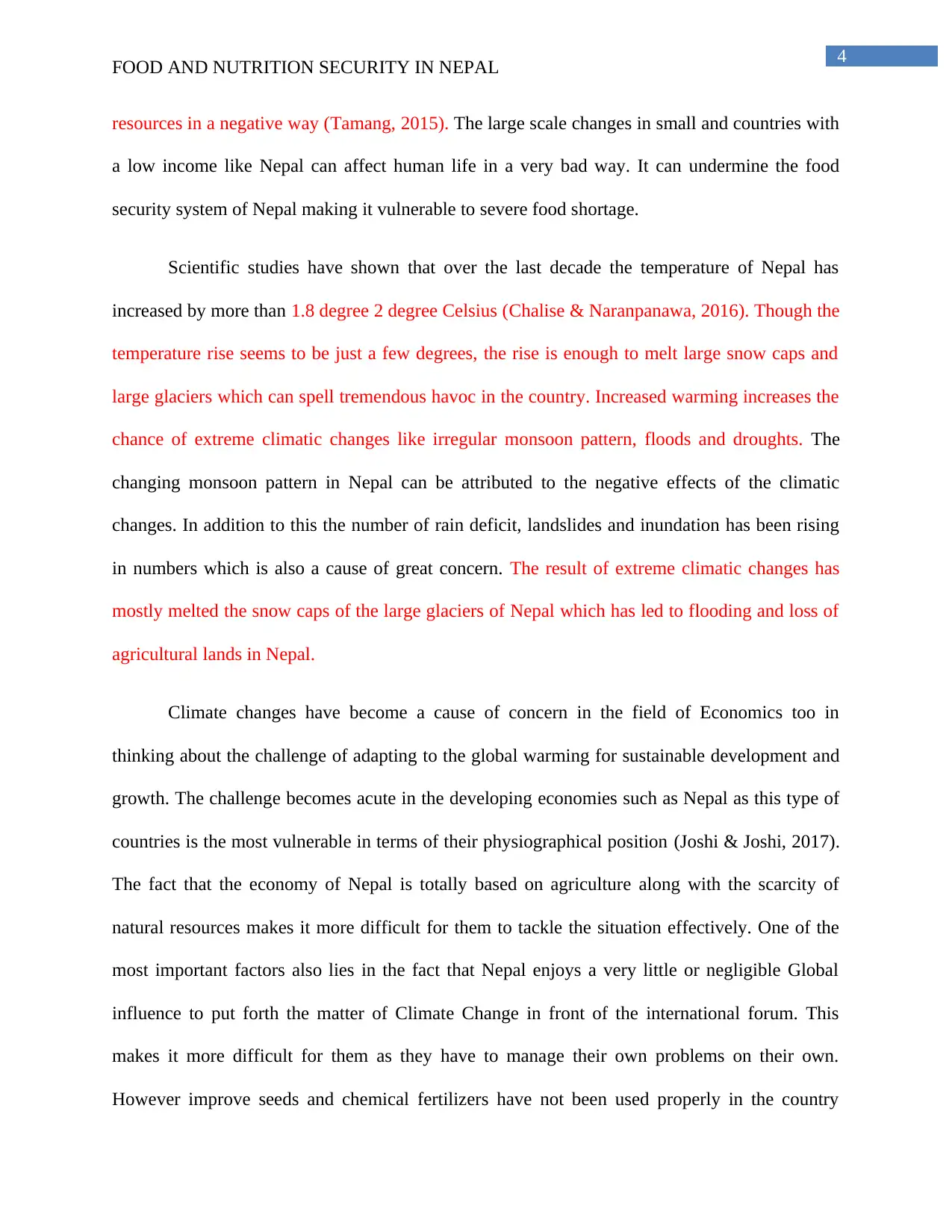
4
FOOD AND NUTRITION SECURITY IN NEPAL
resources in a negative way (Tamang, 2015). The large scale changes in small and countries with
a low income like Nepal can affect human life in a very bad way. It can undermine the food
security system of Nepal making it vulnerable to severe food shortage.
Scientific studies have shown that over the last decade the temperature of Nepal has
increased by more than 1.8 degree 2 degree Celsius (Chalise & Naranpanawa, 2016). Though the
temperature rise seems to be just a few degrees, the rise is enough to melt large snow caps and
large glaciers which can spell tremendous havoc in the country. Increased warming increases the
chance of extreme climatic changes like irregular monsoon pattern, floods and droughts. The
changing monsoon pattern in Nepal can be attributed to the negative effects of the climatic
changes. In addition to this the number of rain deficit, landslides and inundation has been rising
in numbers which is also a cause of great concern. The result of extreme climatic changes has
mostly melted the snow caps of the large glaciers of Nepal which has led to flooding and loss of
agricultural lands in Nepal.
Climate changes have become a cause of concern in the field of Economics too in
thinking about the challenge of adapting to the global warming for sustainable development and
growth. The challenge becomes acute in the developing economies such as Nepal as this type of
countries is the most vulnerable in terms of their physiographical position (Joshi & Joshi, 2017).
The fact that the economy of Nepal is totally based on agriculture along with the scarcity of
natural resources makes it more difficult for them to tackle the situation effectively. One of the
most important factors also lies in the fact that Nepal enjoys a very little or negligible Global
influence to put forth the matter of Climate Change in front of the international forum. This
makes it more difficult for them as they have to manage their own problems on their own.
However improve seeds and chemical fertilizers have not been used properly in the country
FOOD AND NUTRITION SECURITY IN NEPAL
resources in a negative way (Tamang, 2015). The large scale changes in small and countries with
a low income like Nepal can affect human life in a very bad way. It can undermine the food
security system of Nepal making it vulnerable to severe food shortage.
Scientific studies have shown that over the last decade the temperature of Nepal has
increased by more than 1.8 degree 2 degree Celsius (Chalise & Naranpanawa, 2016). Though the
temperature rise seems to be just a few degrees, the rise is enough to melt large snow caps and
large glaciers which can spell tremendous havoc in the country. Increased warming increases the
chance of extreme climatic changes like irregular monsoon pattern, floods and droughts. The
changing monsoon pattern in Nepal can be attributed to the negative effects of the climatic
changes. In addition to this the number of rain deficit, landslides and inundation has been rising
in numbers which is also a cause of great concern. The result of extreme climatic changes has
mostly melted the snow caps of the large glaciers of Nepal which has led to flooding and loss of
agricultural lands in Nepal.
Climate changes have become a cause of concern in the field of Economics too in
thinking about the challenge of adapting to the global warming for sustainable development and
growth. The challenge becomes acute in the developing economies such as Nepal as this type of
countries is the most vulnerable in terms of their physiographical position (Joshi & Joshi, 2017).
The fact that the economy of Nepal is totally based on agriculture along with the scarcity of
natural resources makes it more difficult for them to tackle the situation effectively. One of the
most important factors also lies in the fact that Nepal enjoys a very little or negligible Global
influence to put forth the matter of Climate Change in front of the international forum. This
makes it more difficult for them as they have to manage their own problems on their own.
However improve seeds and chemical fertilizers have not been used properly in the country
Secure Best Marks with AI Grader
Need help grading? Try our AI Grader for instant feedback on your assignments.

5
FOOD AND NUTRITION SECURITY IN NEPAL
which makes it more vulnerable to severe food insecurity. The country should assess the impact
of the climate change in National regional as well as the district level to collect the specific and
detailed information and under been the adaptive policies to the required areas (Gurung 2016).
Global warming and climate change has become the main concern nowadays as it not
only affects the living beings but also the whole ecosystem of the globe. Its impact on agriculture
can be understood directly as the Agro sector is more dependent on natural nurture. The concern
is equally applicable to Nepal has because the early symptoms of Climate Change and
alarmingly increased temperature has raised concerns unknown number of different fonts
concerning Nepal (Joshi & Joshi, 2017). The main change that has been observed over the years
is that Nepal has become a rice importer while just few years back it was one of the main rice
exporters in Asia. The alarming rise in the food grain deficit each and every year is one of the
major concerns of the country. The productivity and the quality of the food production is also in
question as we can both the quality and productivity are deteriorating sharply. Axis and improper
use of chemical fertilizers and pesticides as has attempted to rising health hazards and soil
contamination (Chalise & Naranpanawa, 2016). The rise in soil contamination has led to increase
in pollution and loss of agricultural land. Recently there was a new over it's about middle
Marshyangdi hydro project which initially produced around 70 megawatt electricity but now due
to the decrease water level of the river and weak flow of the water it is capable of producing only
50 megawatt electricity. Such kind of negative results show the consequences of global warming
and change in climate.
The growth of plant as well as the yield is mainly determined by the climatic settings of
the particular topography. The major constraints of plant growth are sunlight, temperature and
rainfall. The agriculture of Nepal is the main contributor to the economy of the country has it
FOOD AND NUTRITION SECURITY IN NEPAL
which makes it more vulnerable to severe food insecurity. The country should assess the impact
of the climate change in National regional as well as the district level to collect the specific and
detailed information and under been the adaptive policies to the required areas (Gurung 2016).
Global warming and climate change has become the main concern nowadays as it not
only affects the living beings but also the whole ecosystem of the globe. Its impact on agriculture
can be understood directly as the Agro sector is more dependent on natural nurture. The concern
is equally applicable to Nepal has because the early symptoms of Climate Change and
alarmingly increased temperature has raised concerns unknown number of different fonts
concerning Nepal (Joshi & Joshi, 2017). The main change that has been observed over the years
is that Nepal has become a rice importer while just few years back it was one of the main rice
exporters in Asia. The alarming rise in the food grain deficit each and every year is one of the
major concerns of the country. The productivity and the quality of the food production is also in
question as we can both the quality and productivity are deteriorating sharply. Axis and improper
use of chemical fertilizers and pesticides as has attempted to rising health hazards and soil
contamination (Chalise & Naranpanawa, 2016). The rise in soil contamination has led to increase
in pollution and loss of agricultural land. Recently there was a new over it's about middle
Marshyangdi hydro project which initially produced around 70 megawatt electricity but now due
to the decrease water level of the river and weak flow of the water it is capable of producing only
50 megawatt electricity. Such kind of negative results show the consequences of global warming
and change in climate.
The growth of plant as well as the yield is mainly determined by the climatic settings of
the particular topography. The major constraints of plant growth are sunlight, temperature and
rainfall. The agriculture of Nepal is the main contributor to the economy of the country has it
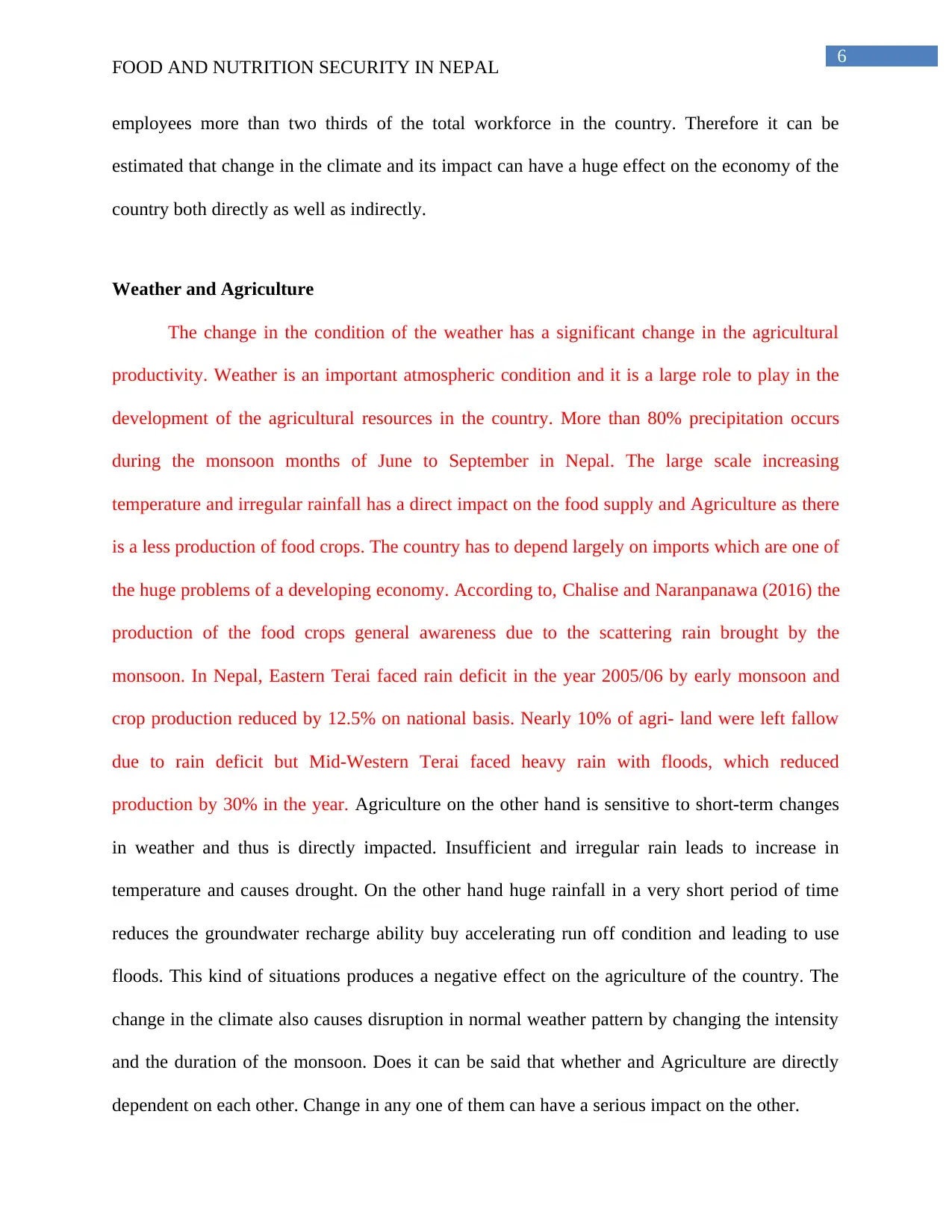
6
FOOD AND NUTRITION SECURITY IN NEPAL
employees more than two thirds of the total workforce in the country. Therefore it can be
estimated that change in the climate and its impact can have a huge effect on the economy of the
country both directly as well as indirectly.
Weather and Agriculture
The change in the condition of the weather has a significant change in the agricultural
productivity. Weather is an important atmospheric condition and it is a large role to play in the
development of the agricultural resources in the country. More than 80% precipitation occurs
during the monsoon months of June to September in Nepal. The large scale increasing
temperature and irregular rainfall has a direct impact on the food supply and Agriculture as there
is a less production of food crops. The country has to depend largely on imports which are one of
the huge problems of a developing economy. According to, Chalise and Naranpanawa (2016) the
production of the food crops general awareness due to the scattering rain brought by the
monsoon. In Nepal, Eastern Terai faced rain deficit in the year 2005/06 by early monsoon and
crop production reduced by 12.5% on national basis. Nearly 10% of agri- land were left fallow
due to rain deficit but Mid-Western Terai faced heavy rain with floods, which reduced
production by 30% in the year. Agriculture on the other hand is sensitive to short-term changes
in weather and thus is directly impacted. Insufficient and irregular rain leads to increase in
temperature and causes drought. On the other hand huge rainfall in a very short period of time
reduces the groundwater recharge ability buy accelerating run off condition and leading to use
floods. This kind of situations produces a negative effect on the agriculture of the country. The
change in the climate also causes disruption in normal weather pattern by changing the intensity
and the duration of the monsoon. Does it can be said that whether and Agriculture are directly
dependent on each other. Change in any one of them can have a serious impact on the other.
FOOD AND NUTRITION SECURITY IN NEPAL
employees more than two thirds of the total workforce in the country. Therefore it can be
estimated that change in the climate and its impact can have a huge effect on the economy of the
country both directly as well as indirectly.
Weather and Agriculture
The change in the condition of the weather has a significant change in the agricultural
productivity. Weather is an important atmospheric condition and it is a large role to play in the
development of the agricultural resources in the country. More than 80% precipitation occurs
during the monsoon months of June to September in Nepal. The large scale increasing
temperature and irregular rainfall has a direct impact on the food supply and Agriculture as there
is a less production of food crops. The country has to depend largely on imports which are one of
the huge problems of a developing economy. According to, Chalise and Naranpanawa (2016) the
production of the food crops general awareness due to the scattering rain brought by the
monsoon. In Nepal, Eastern Terai faced rain deficit in the year 2005/06 by early monsoon and
crop production reduced by 12.5% on national basis. Nearly 10% of agri- land were left fallow
due to rain deficit but Mid-Western Terai faced heavy rain with floods, which reduced
production by 30% in the year. Agriculture on the other hand is sensitive to short-term changes
in weather and thus is directly impacted. Insufficient and irregular rain leads to increase in
temperature and causes drought. On the other hand huge rainfall in a very short period of time
reduces the groundwater recharge ability buy accelerating run off condition and leading to use
floods. This kind of situations produces a negative effect on the agriculture of the country. The
change in the climate also causes disruption in normal weather pattern by changing the intensity
and the duration of the monsoon. Does it can be said that whether and Agriculture are directly
dependent on each other. Change in any one of them can have a serious impact on the other.
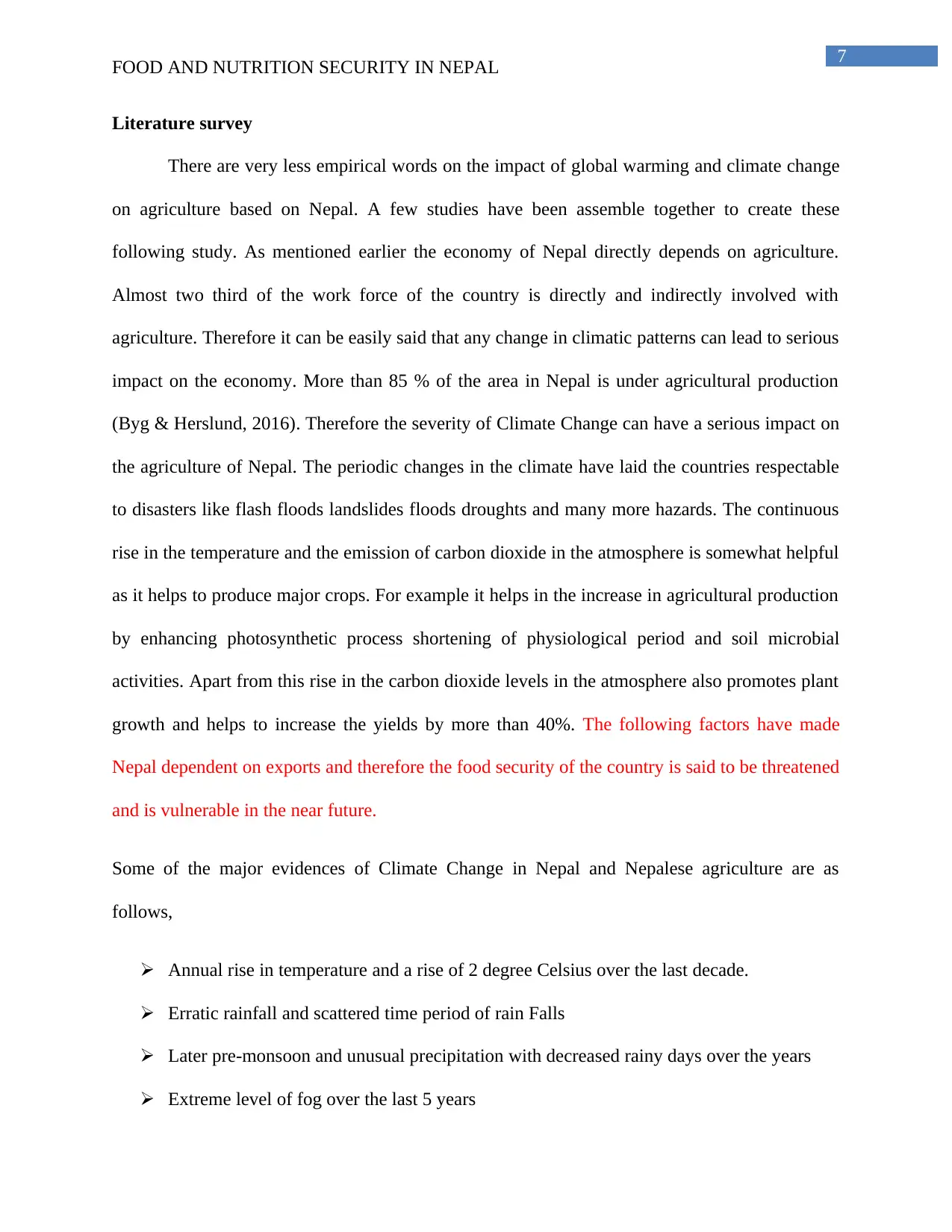
7
FOOD AND NUTRITION SECURITY IN NEPAL
Literature survey
There are very less empirical words on the impact of global warming and climate change
on agriculture based on Nepal. A few studies have been assemble together to create these
following study. As mentioned earlier the economy of Nepal directly depends on agriculture.
Almost two third of the work force of the country is directly and indirectly involved with
agriculture. Therefore it can be easily said that any change in climatic patterns can lead to serious
impact on the economy. More than 85 % of the area in Nepal is under agricultural production
(Byg & Herslund, 2016). Therefore the severity of Climate Change can have a serious impact on
the agriculture of Nepal. The periodic changes in the climate have laid the countries respectable
to disasters like flash floods landslides floods droughts and many more hazards. The continuous
rise in the temperature and the emission of carbon dioxide in the atmosphere is somewhat helpful
as it helps to produce major crops. For example it helps in the increase in agricultural production
by enhancing photosynthetic process shortening of physiological period and soil microbial
activities. Apart from this rise in the carbon dioxide levels in the atmosphere also promotes plant
growth and helps to increase the yields by more than 40%. The following factors have made
Nepal dependent on exports and therefore the food security of the country is said to be threatened
and is vulnerable in the near future.
Some of the major evidences of Climate Change in Nepal and Nepalese agriculture are as
follows,
Annual rise in temperature and a rise of 2 degree Celsius over the last decade.
Erratic rainfall and scattered time period of rain Falls
Later pre-monsoon and unusual precipitation with decreased rainy days over the years
Extreme level of fog over the last 5 years
FOOD AND NUTRITION SECURITY IN NEPAL
Literature survey
There are very less empirical words on the impact of global warming and climate change
on agriculture based on Nepal. A few studies have been assemble together to create these
following study. As mentioned earlier the economy of Nepal directly depends on agriculture.
Almost two third of the work force of the country is directly and indirectly involved with
agriculture. Therefore it can be easily said that any change in climatic patterns can lead to serious
impact on the economy. More than 85 % of the area in Nepal is under agricultural production
(Byg & Herslund, 2016). Therefore the severity of Climate Change can have a serious impact on
the agriculture of Nepal. The periodic changes in the climate have laid the countries respectable
to disasters like flash floods landslides floods droughts and many more hazards. The continuous
rise in the temperature and the emission of carbon dioxide in the atmosphere is somewhat helpful
as it helps to produce major crops. For example it helps in the increase in agricultural production
by enhancing photosynthetic process shortening of physiological period and soil microbial
activities. Apart from this rise in the carbon dioxide levels in the atmosphere also promotes plant
growth and helps to increase the yields by more than 40%. The following factors have made
Nepal dependent on exports and therefore the food security of the country is said to be threatened
and is vulnerable in the near future.
Some of the major evidences of Climate Change in Nepal and Nepalese agriculture are as
follows,
Annual rise in temperature and a rise of 2 degree Celsius over the last decade.
Erratic rainfall and scattered time period of rain Falls
Later pre-monsoon and unusual precipitation with decreased rainy days over the years
Extreme level of fog over the last 5 years
Paraphrase This Document
Need a fresh take? Get an instant paraphrase of this document with our AI Paraphraser
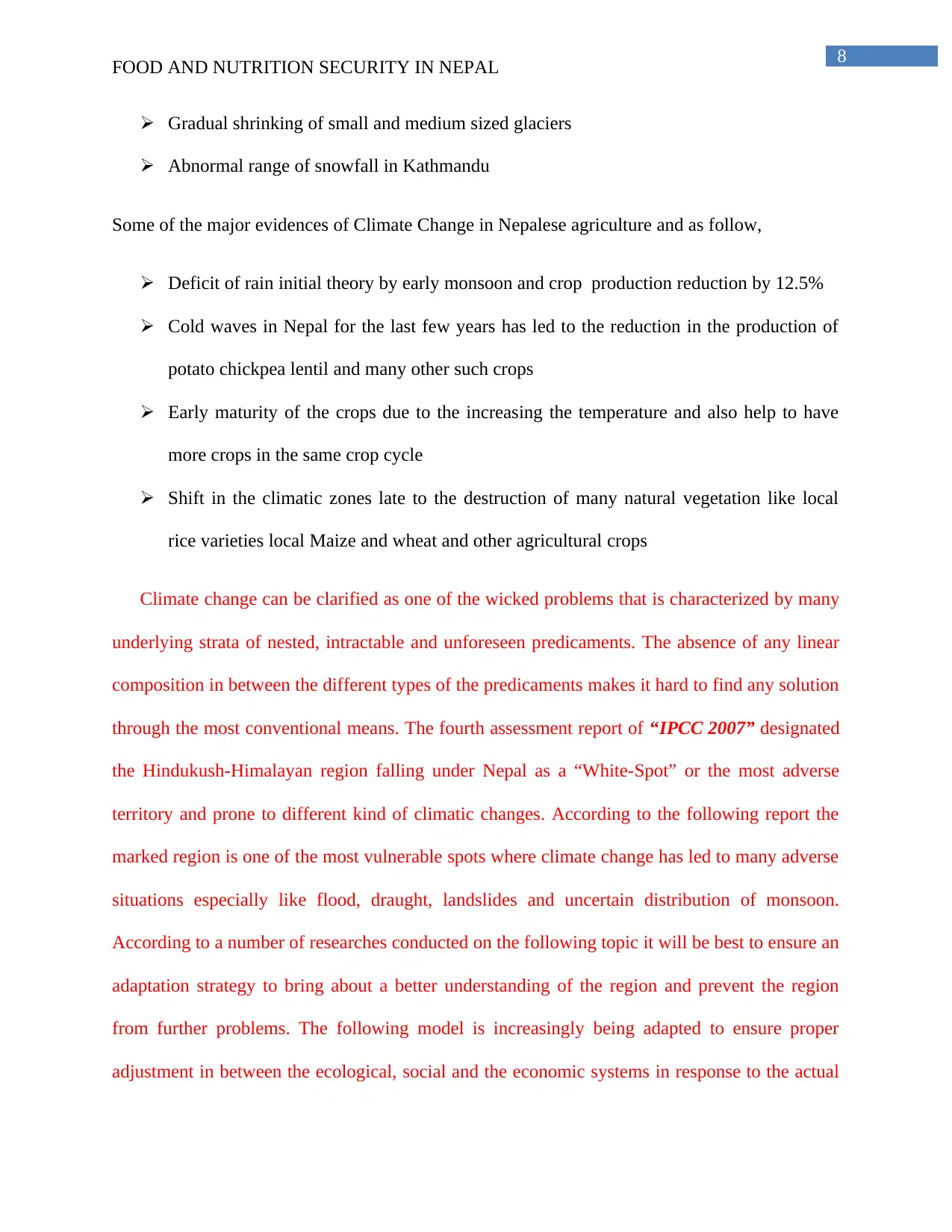
8
FOOD AND NUTRITION SECURITY IN NEPAL
Gradual shrinking of small and medium sized glaciers
Abnormal range of snowfall in Kathmandu
Some of the major evidences of Climate Change in Nepalese agriculture and as follow,
Deficit of rain initial theory by early monsoon and crop production reduction by 12.5%
Cold waves in Nepal for the last few years has led to the reduction in the production of
potato chickpea lentil and many other such crops
Early maturity of the crops due to the increasing the temperature and also help to have
more crops in the same crop cycle
Shift in the climatic zones late to the destruction of many natural vegetation like local
rice varieties local Maize and wheat and other agricultural crops
Climate change can be clarified as one of the wicked problems that is characterized by many
underlying strata of nested, intractable and unforeseen predicaments. The absence of any linear
composition in between the different types of the predicaments makes it hard to find any solution
through the most conventional means. The fourth assessment report of “IPCC 2007” designated
the Hindukush-Himalayan region falling under Nepal as a “White-Spot” or the most adverse
territory and prone to different kind of climatic changes. According to the following report the
marked region is one of the most vulnerable spots where climate change has led to many adverse
situations especially like flood, draught, landslides and uncertain distribution of monsoon.
According to a number of researches conducted on the following topic it will be best to ensure an
adaptation strategy to bring about a better understanding of the region and prevent the region
from further problems. The following model is increasingly being adapted to ensure proper
adjustment in between the ecological, social and the economic systems in response to the actual
FOOD AND NUTRITION SECURITY IN NEPAL
Gradual shrinking of small and medium sized glaciers
Abnormal range of snowfall in Kathmandu
Some of the major evidences of Climate Change in Nepalese agriculture and as follow,
Deficit of rain initial theory by early monsoon and crop production reduction by 12.5%
Cold waves in Nepal for the last few years has led to the reduction in the production of
potato chickpea lentil and many other such crops
Early maturity of the crops due to the increasing the temperature and also help to have
more crops in the same crop cycle
Shift in the climatic zones late to the destruction of many natural vegetation like local
rice varieties local Maize and wheat and other agricultural crops
Climate change can be clarified as one of the wicked problems that is characterized by many
underlying strata of nested, intractable and unforeseen predicaments. The absence of any linear
composition in between the different types of the predicaments makes it hard to find any solution
through the most conventional means. The fourth assessment report of “IPCC 2007” designated
the Hindukush-Himalayan region falling under Nepal as a “White-Spot” or the most adverse
territory and prone to different kind of climatic changes. According to the following report the
marked region is one of the most vulnerable spots where climate change has led to many adverse
situations especially like flood, draught, landslides and uncertain distribution of monsoon.
According to a number of researches conducted on the following topic it will be best to ensure an
adaptation strategy to bring about a better understanding of the region and prevent the region
from further problems. The following model is increasingly being adapted to ensure proper
adjustment in between the ecological, social and the economic systems in response to the actual
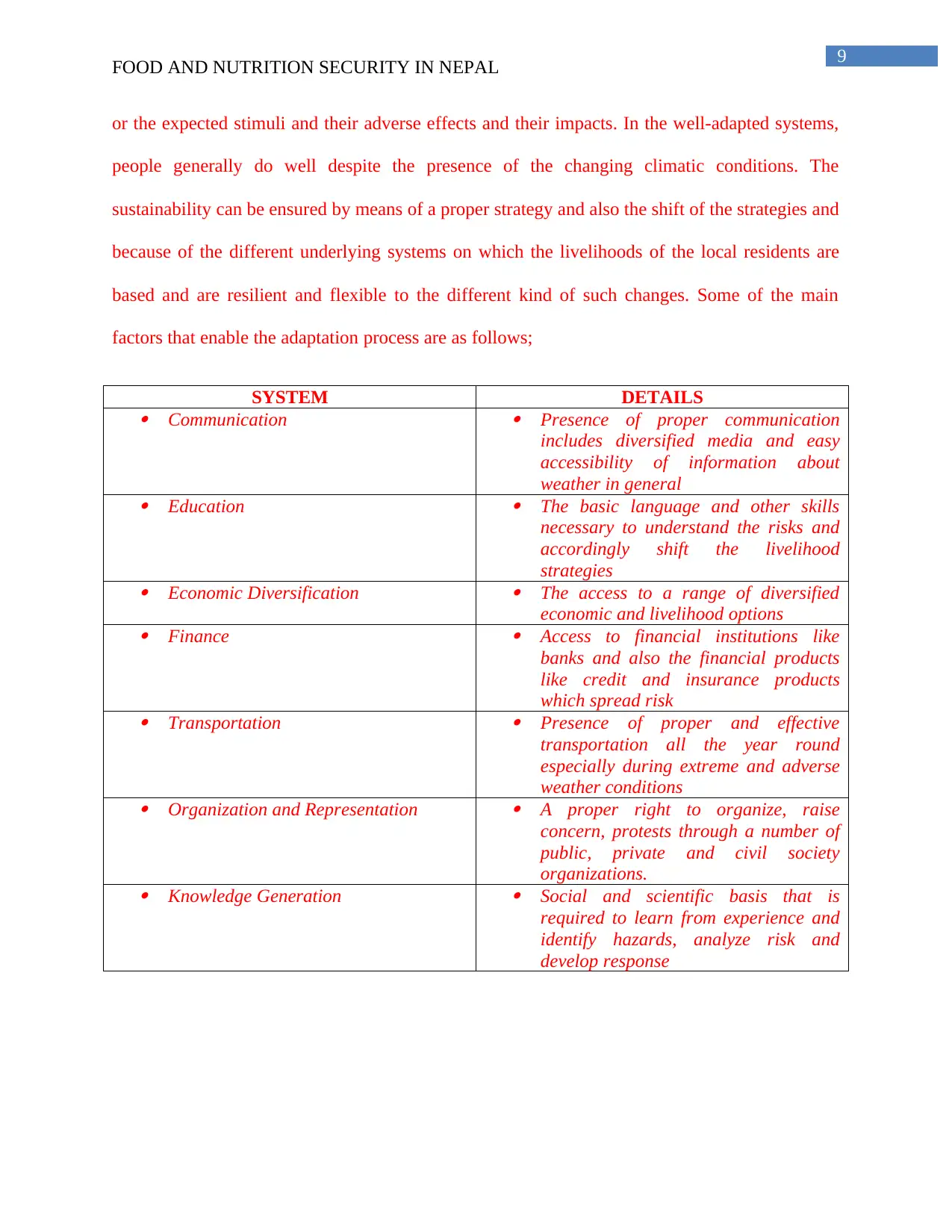
9
FOOD AND NUTRITION SECURITY IN NEPAL
or the expected stimuli and their adverse effects and their impacts. In the well-adapted systems,
people generally do well despite the presence of the changing climatic conditions. The
sustainability can be ensured by means of a proper strategy and also the shift of the strategies and
because of the different underlying systems on which the livelihoods of the local residents are
based and are resilient and flexible to the different kind of such changes. Some of the main
factors that enable the adaptation process are as follows;
SYSTEM DETAILS
Communication
Presence of proper communication
includes diversified media and easy
accessibility of information about
weather in general
Education
The basic language and other skills
necessary to understand the risks and
accordingly shift the livelihood
strategies
Economic Diversification
The access to a range of diversified
economic and livelihood options
Finance
Access to financial institutions like
banks and also the financial products
like credit and insurance products
which spread risk
Transportation
Presence of proper and effective
transportation all the year round
especially during extreme and adverse
weather conditions
Organization and Representation
A proper right to organize, raise
concern, protests through a number of
public, private and civil society
organizations.
Knowledge Generation
Social and scientific basis that is
required to learn from experience and
identify hazards, analyze risk and
develop response
FOOD AND NUTRITION SECURITY IN NEPAL
or the expected stimuli and their adverse effects and their impacts. In the well-adapted systems,
people generally do well despite the presence of the changing climatic conditions. The
sustainability can be ensured by means of a proper strategy and also the shift of the strategies and
because of the different underlying systems on which the livelihoods of the local residents are
based and are resilient and flexible to the different kind of such changes. Some of the main
factors that enable the adaptation process are as follows;
SYSTEM DETAILS
Communication
Presence of proper communication
includes diversified media and easy
accessibility of information about
weather in general
Education
The basic language and other skills
necessary to understand the risks and
accordingly shift the livelihood
strategies
Economic Diversification
The access to a range of diversified
economic and livelihood options
Finance
Access to financial institutions like
banks and also the financial products
like credit and insurance products
which spread risk
Transportation
Presence of proper and effective
transportation all the year round
especially during extreme and adverse
weather conditions
Organization and Representation
A proper right to organize, raise
concern, protests through a number of
public, private and civil society
organizations.
Knowledge Generation
Social and scientific basis that is
required to learn from experience and
identify hazards, analyze risk and
develop response
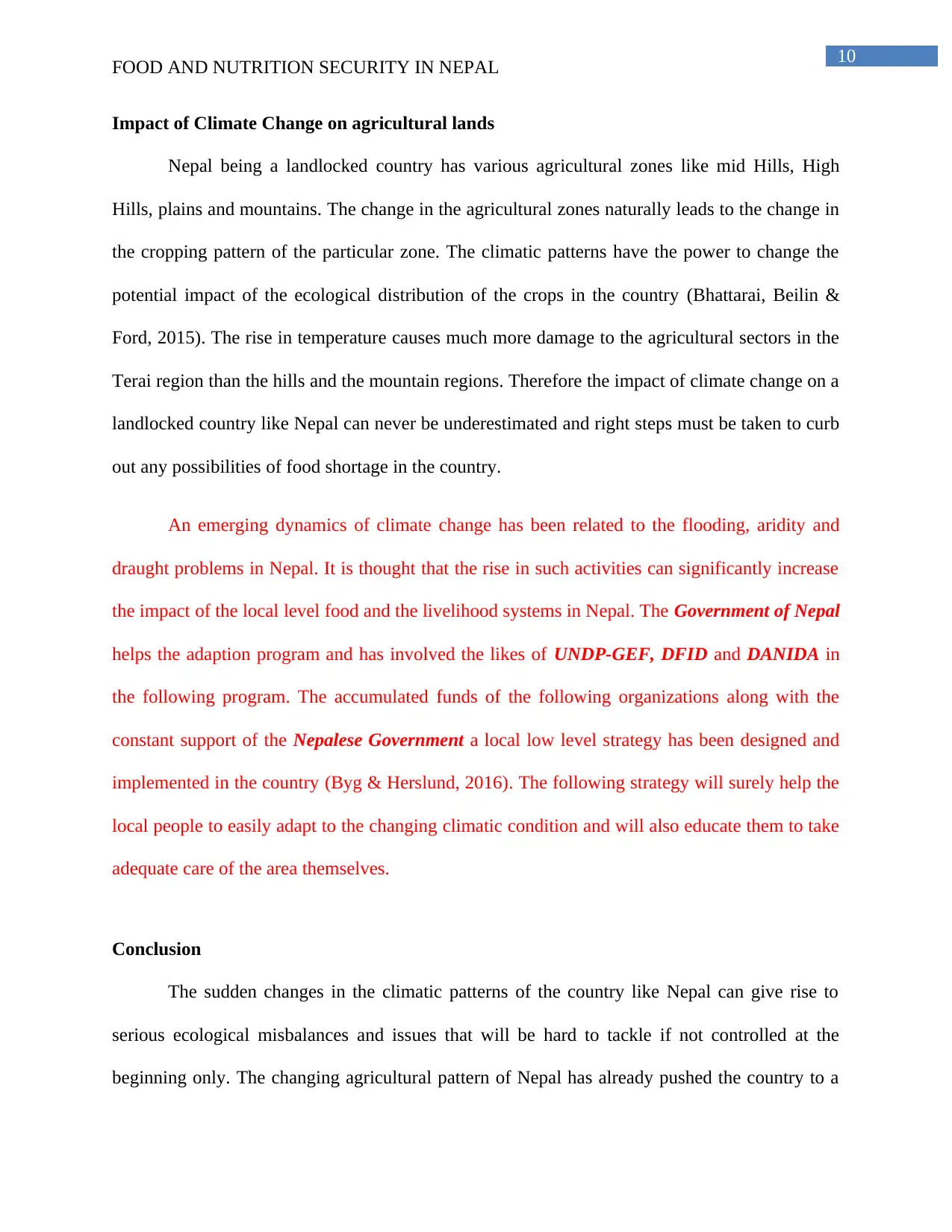
10
FOOD AND NUTRITION SECURITY IN NEPAL
Impact of Climate Change on agricultural lands
Nepal being a landlocked country has various agricultural zones like mid Hills, High
Hills, plains and mountains. The change in the agricultural zones naturally leads to the change in
the cropping pattern of the particular zone. The climatic patterns have the power to change the
potential impact of the ecological distribution of the crops in the country (Bhattarai, Beilin &
Ford, 2015). The rise in temperature causes much more damage to the agricultural sectors in the
Terai region than the hills and the mountain regions. Therefore the impact of climate change on a
landlocked country like Nepal can never be underestimated and right steps must be taken to curb
out any possibilities of food shortage in the country.
An emerging dynamics of climate change has been related to the flooding, aridity and
draught problems in Nepal. It is thought that the rise in such activities can significantly increase
the impact of the local level food and the livelihood systems in Nepal. The Government of Nepal
helps the adaption program and has involved the likes of UNDP-GEF, DFID and DANIDA in
the following program. The accumulated funds of the following organizations along with the
constant support of the Nepalese Government a local low level strategy has been designed and
implemented in the country (Byg & Herslund, 2016). The following strategy will surely help the
local people to easily adapt to the changing climatic condition and will also educate them to take
adequate care of the area themselves.
Conclusion
The sudden changes in the climatic patterns of the country like Nepal can give rise to
serious ecological misbalances and issues that will be hard to tackle if not controlled at the
beginning only. The changing agricultural pattern of Nepal has already pushed the country to a
FOOD AND NUTRITION SECURITY IN NEPAL
Impact of Climate Change on agricultural lands
Nepal being a landlocked country has various agricultural zones like mid Hills, High
Hills, plains and mountains. The change in the agricultural zones naturally leads to the change in
the cropping pattern of the particular zone. The climatic patterns have the power to change the
potential impact of the ecological distribution of the crops in the country (Bhattarai, Beilin &
Ford, 2015). The rise in temperature causes much more damage to the agricultural sectors in the
Terai region than the hills and the mountain regions. Therefore the impact of climate change on a
landlocked country like Nepal can never be underestimated and right steps must be taken to curb
out any possibilities of food shortage in the country.
An emerging dynamics of climate change has been related to the flooding, aridity and
draught problems in Nepal. It is thought that the rise in such activities can significantly increase
the impact of the local level food and the livelihood systems in Nepal. The Government of Nepal
helps the adaption program and has involved the likes of UNDP-GEF, DFID and DANIDA in
the following program. The accumulated funds of the following organizations along with the
constant support of the Nepalese Government a local low level strategy has been designed and
implemented in the country (Byg & Herslund, 2016). The following strategy will surely help the
local people to easily adapt to the changing climatic condition and will also educate them to take
adequate care of the area themselves.
Conclusion
The sudden changes in the climatic patterns of the country like Nepal can give rise to
serious ecological misbalances and issues that will be hard to tackle if not controlled at the
beginning only. The changing agricultural pattern of Nepal has already pushed the country to a
Secure Best Marks with AI Grader
Need help grading? Try our AI Grader for instant feedback on your assignments.
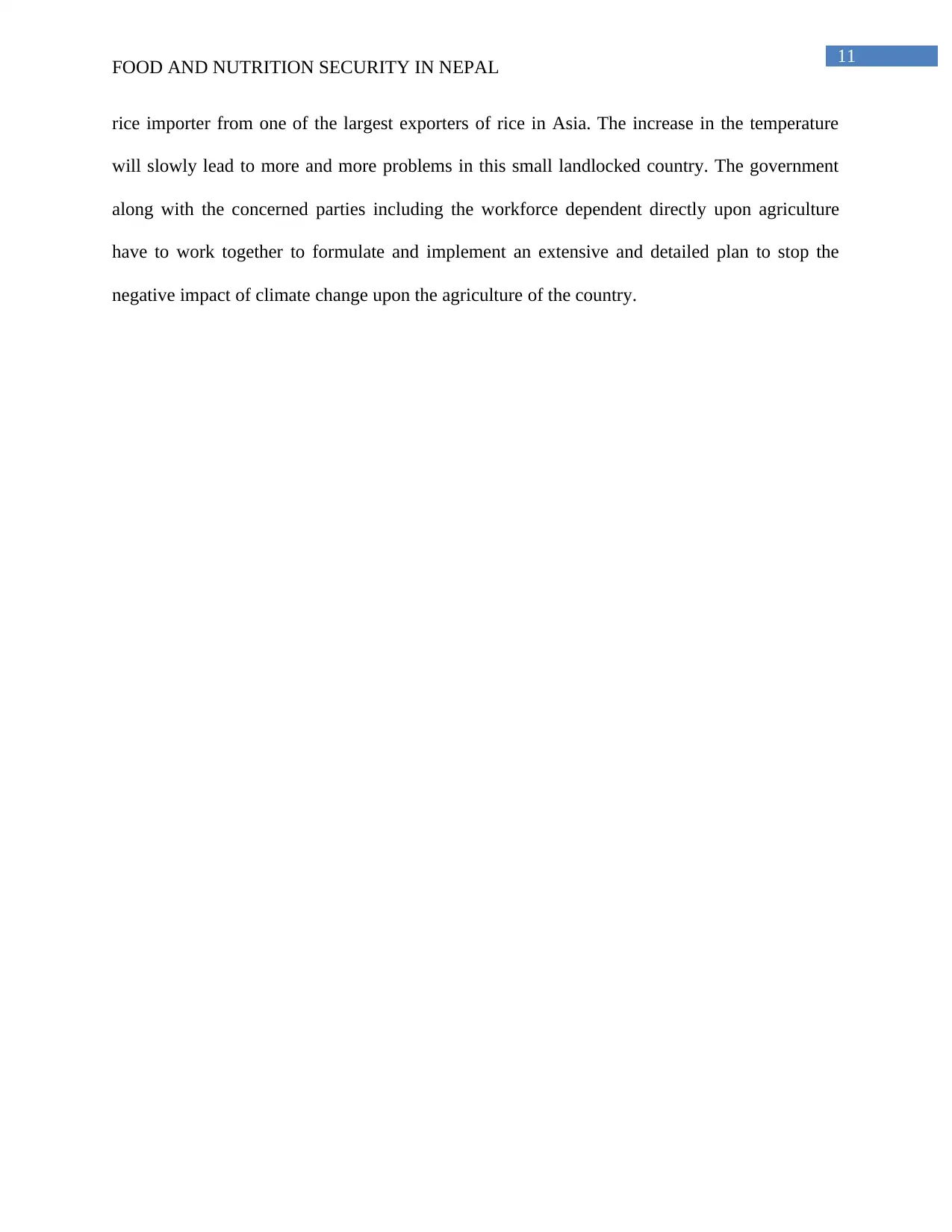
11
FOOD AND NUTRITION SECURITY IN NEPAL
rice importer from one of the largest exporters of rice in Asia. The increase in the temperature
will slowly lead to more and more problems in this small landlocked country. The government
along with the concerned parties including the workforce dependent directly upon agriculture
have to work together to formulate and implement an extensive and detailed plan to stop the
negative impact of climate change upon the agriculture of the country.
FOOD AND NUTRITION SECURITY IN NEPAL
rice importer from one of the largest exporters of rice in Asia. The increase in the temperature
will slowly lead to more and more problems in this small landlocked country. The government
along with the concerned parties including the workforce dependent directly upon agriculture
have to work together to formulate and implement an extensive and detailed plan to stop the
negative impact of climate change upon the agriculture of the country.
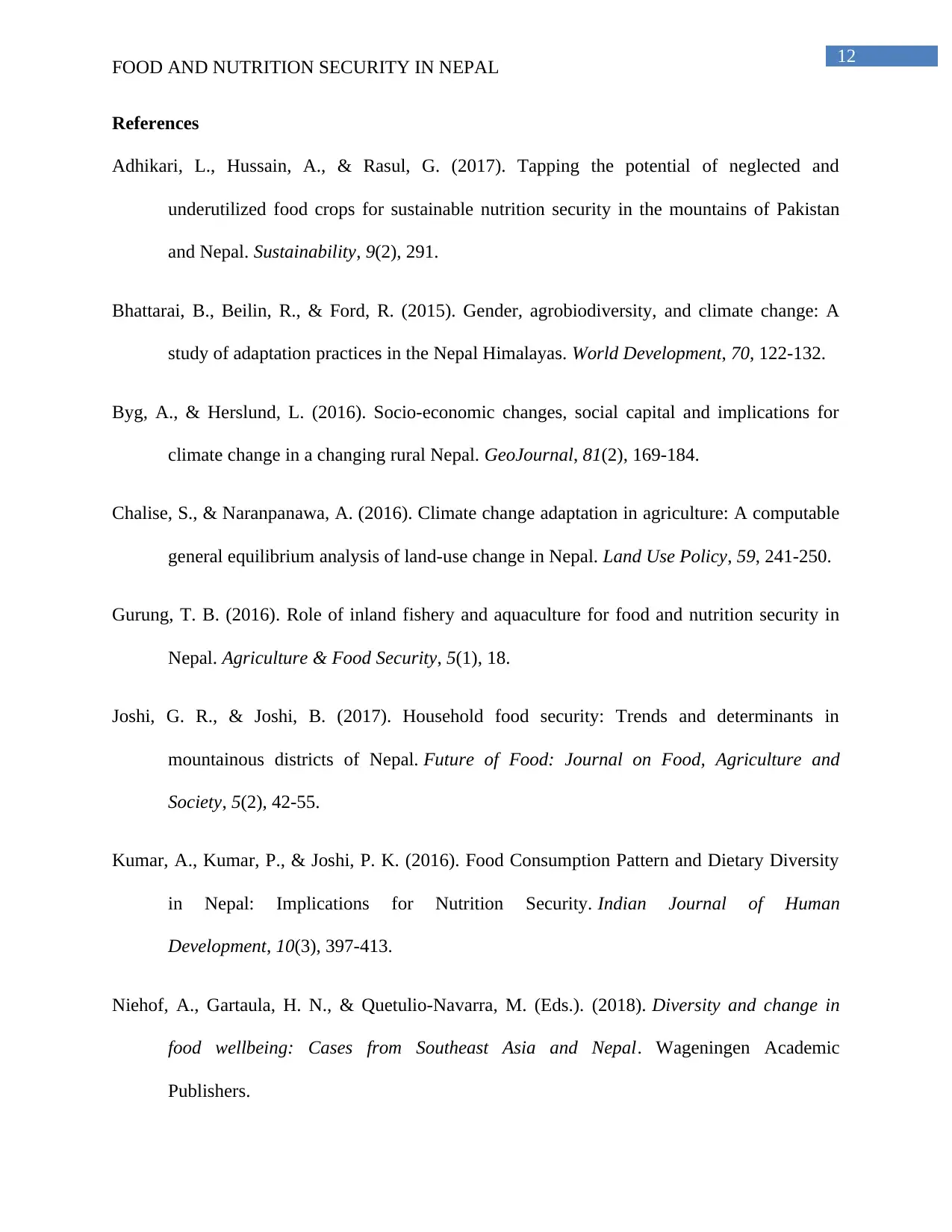
12
FOOD AND NUTRITION SECURITY IN NEPAL
References
Adhikari, L., Hussain, A., & Rasul, G. (2017). Tapping the potential of neglected and
underutilized food crops for sustainable nutrition security in the mountains of Pakistan
and Nepal. Sustainability, 9(2), 291.
Bhattarai, B., Beilin, R., & Ford, R. (2015). Gender, agrobiodiversity, and climate change: A
study of adaptation practices in the Nepal Himalayas. World Development, 70, 122-132.
Byg, A., & Herslund, L. (2016). Socio-economic changes, social capital and implications for
climate change in a changing rural Nepal. GeoJournal, 81(2), 169-184.
Chalise, S., & Naranpanawa, A. (2016). Climate change adaptation in agriculture: A computable
general equilibrium analysis of land-use change in Nepal. Land Use Policy, 59, 241-250.
Gurung, T. B. (2016). Role of inland fishery and aquaculture for food and nutrition security in
Nepal. Agriculture & Food Security, 5(1), 18.
Joshi, G. R., & Joshi, B. (2017). Household food security: Trends and determinants in
mountainous districts of Nepal. Future of Food: Journal on Food, Agriculture and
Society, 5(2), 42-55.
Kumar, A., Kumar, P., & Joshi, P. K. (2016). Food Consumption Pattern and Dietary Diversity
in Nepal: Implications for Nutrition Security. Indian Journal of Human
Development, 10(3), 397-413.
Niehof, A., Gartaula, H. N., & Quetulio-Navarra, M. (Eds.). (2018). Diversity and change in
food wellbeing: Cases from Southeast Asia and Nepal. Wageningen Academic
Publishers.
FOOD AND NUTRITION SECURITY IN NEPAL
References
Adhikari, L., Hussain, A., & Rasul, G. (2017). Tapping the potential of neglected and
underutilized food crops for sustainable nutrition security in the mountains of Pakistan
and Nepal. Sustainability, 9(2), 291.
Bhattarai, B., Beilin, R., & Ford, R. (2015). Gender, agrobiodiversity, and climate change: A
study of adaptation practices in the Nepal Himalayas. World Development, 70, 122-132.
Byg, A., & Herslund, L. (2016). Socio-economic changes, social capital and implications for
climate change in a changing rural Nepal. GeoJournal, 81(2), 169-184.
Chalise, S., & Naranpanawa, A. (2016). Climate change adaptation in agriculture: A computable
general equilibrium analysis of land-use change in Nepal. Land Use Policy, 59, 241-250.
Gurung, T. B. (2016). Role of inland fishery and aquaculture for food and nutrition security in
Nepal. Agriculture & Food Security, 5(1), 18.
Joshi, G. R., & Joshi, B. (2017). Household food security: Trends and determinants in
mountainous districts of Nepal. Future of Food: Journal on Food, Agriculture and
Society, 5(2), 42-55.
Kumar, A., Kumar, P., & Joshi, P. K. (2016). Food Consumption Pattern and Dietary Diversity
in Nepal: Implications for Nutrition Security. Indian Journal of Human
Development, 10(3), 397-413.
Niehof, A., Gartaula, H. N., & Quetulio-Navarra, M. (Eds.). (2018). Diversity and change in
food wellbeing: Cases from Southeast Asia and Nepal. Wageningen Academic
Publishers.
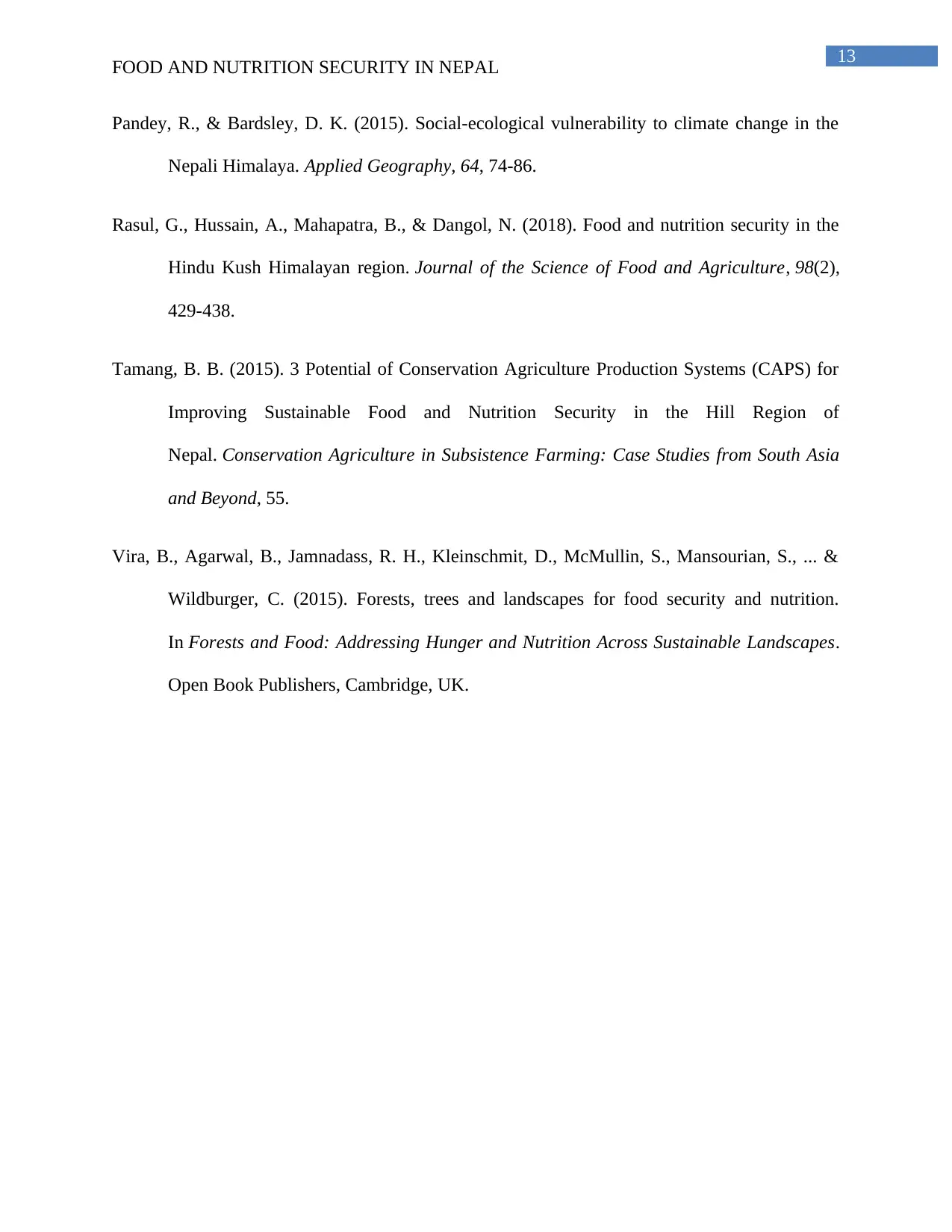
13
FOOD AND NUTRITION SECURITY IN NEPAL
Pandey, R., & Bardsley, D. K. (2015). Social-ecological vulnerability to climate change in the
Nepali Himalaya. Applied Geography, 64, 74-86.
Rasul, G., Hussain, A., Mahapatra, B., & Dangol, N. (2018). Food and nutrition security in the
Hindu Kush Himalayan region. Journal of the Science of Food and Agriculture, 98(2),
429-438.
Tamang, B. B. (2015). 3 Potential of Conservation Agriculture Production Systems (CAPS) for
Improving Sustainable Food and Nutrition Security in the Hill Region of
Nepal. Conservation Agriculture in Subsistence Farming: Case Studies from South Asia
and Beyond, 55.
Vira, B., Agarwal, B., Jamnadass, R. H., Kleinschmit, D., McMullin, S., Mansourian, S., ... &
Wildburger, C. (2015). Forests, trees and landscapes for food security and nutrition.
In Forests and Food: Addressing Hunger and Nutrition Across Sustainable Landscapes.
Open Book Publishers, Cambridge, UK.
FOOD AND NUTRITION SECURITY IN NEPAL
Pandey, R., & Bardsley, D. K. (2015). Social-ecological vulnerability to climate change in the
Nepali Himalaya. Applied Geography, 64, 74-86.
Rasul, G., Hussain, A., Mahapatra, B., & Dangol, N. (2018). Food and nutrition security in the
Hindu Kush Himalayan region. Journal of the Science of Food and Agriculture, 98(2),
429-438.
Tamang, B. B. (2015). 3 Potential of Conservation Agriculture Production Systems (CAPS) for
Improving Sustainable Food and Nutrition Security in the Hill Region of
Nepal. Conservation Agriculture in Subsistence Farming: Case Studies from South Asia
and Beyond, 55.
Vira, B., Agarwal, B., Jamnadass, R. H., Kleinschmit, D., McMullin, S., Mansourian, S., ... &
Wildburger, C. (2015). Forests, trees and landscapes for food security and nutrition.
In Forests and Food: Addressing Hunger and Nutrition Across Sustainable Landscapes.
Open Book Publishers, Cambridge, UK.
1 out of 13
Related Documents
Your All-in-One AI-Powered Toolkit for Academic Success.
+13062052269
info@desklib.com
Available 24*7 on WhatsApp / Email
![[object Object]](/_next/static/media/star-bottom.7253800d.svg)
Unlock your academic potential
© 2024 | Zucol Services PVT LTD | All rights reserved.





